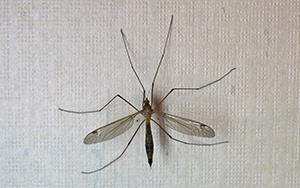
The onset of late spring leading into summer often invites various insects into our surroundings, some more welcome than others. One common case of mistaken identity occurs when crane flies are misidentified as mosquitoes. While these long-legged insects may resemble their bloodsucking doppelganger at first glance, distinguishing between can save you some worry, and even help your soil.
What’s the Difference?
At first glance, crane flies and mosquitoes might seem almost indistinguishable, especially when observed in the dim light of dusk or dawn. They have similar appearance and grow in similar environments, however there are a few key differences.
Crane Flies
Commonly referred to as “mosquito hawks” or “mosquito eaters”, crane flies are a species of fly that have no relation to mosquitoes despite their nicknames. Here’s how to spot them:
- Long legs with multiple joints
- Can grow up to 3 times larger than mosquitoes with some species spanning up to 1.2 inches long
- Long and narrow abdomen
- Wings set on side of body and do not fold when at rest
- No proboscis (long pointed mouth) to bite with
- Poor fliers
- Live in adulthood for 10-15 days
- Eat nectar
- Attracted to light, nectar, and moisture
These gentle giants are generally slower and easier to catch than their smaller lookalike, and completely harmless. They cannot bite, and do not spread disease. Males spend their entire adulthood seeking out females for mating and eating nectar, while the females seek out nectar and high moisture areas ideal for their eggs. In their larvae state, crane flies are highly beneficial to soil because they eat decaying organic matter, and their presence has been noted to improve the lifecycle of plants and flowers.
Mosquitoes
These blood sucking pests are a nuisance more trouble than they’re worth. In their larvae state they can provide some benefit as a nutritious snack for fish and by adding nitrogen to the water they inhabit, but that’s where the benefits end. How to identify them:
- Short legs with multiple joints
- Never bigger than about half an inch
- Short and wide abdomen
- Wings set backwards and fold when at rest
- Long proboscis (pointed mouth) for biting
- Strong fliers
- Need organic material from blood for their eggs
- Spread deadly disease like malaria, dengue, and Zika
Mosquitoes thrive in areas of high moisture with standing or stagnant water and pose a health threat to you and your family. They are tiny, and often go unnoticed unless in swarms or if they have already bitten you, leaving behind itchy welts in their wake.
Your Partners in Pest Control
At Johnson Pest Control, we understand not wanting to take a chance with your health. Tennessee’s first company to receive the National Pest Management Associations Quality Pro Company of Choice award, we have been dedicated to providing quality service to our community for over 30 years. With innovative solutions and leading technology, we know how to keep your home pest free year-round – even the non-dangerous ones. Don’t hesitate to request a professional evaluation, give us a call today for a free quote!
Crane Flies vs Mosquitoes: A Case of Mistaken Identity in Sevierville TN
Serving Sevier County and surrounding areas since 1984